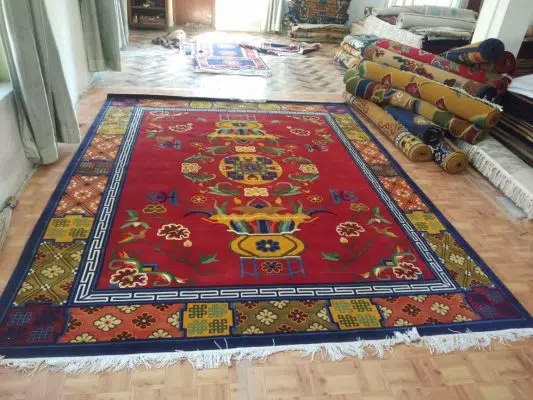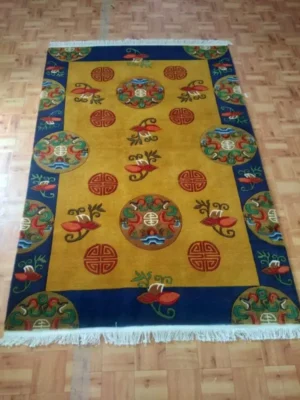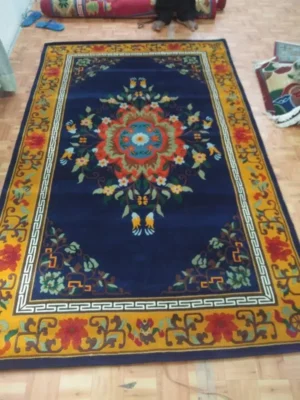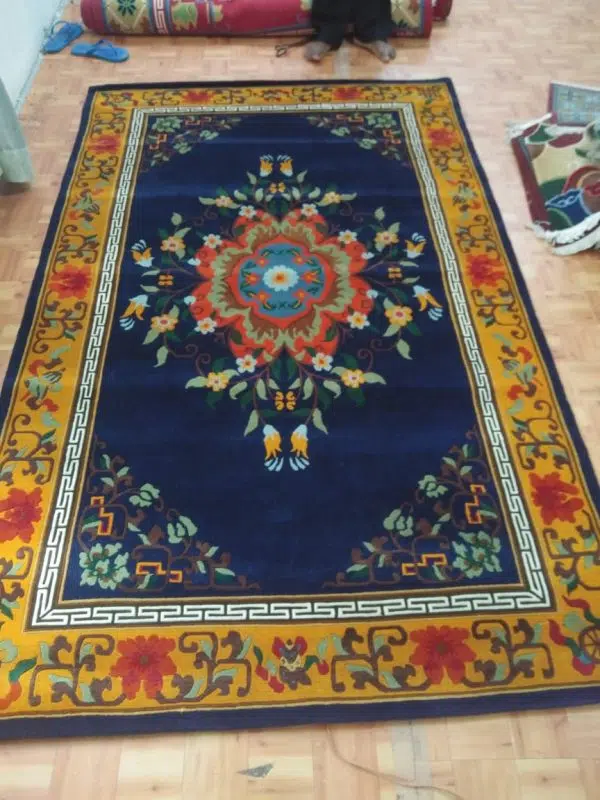Blog
High-Altitude Wool Carpets
![]()
Table of Contents
Introduction to High-Altitude Wool Carpets
High-Altitude Wool Carpets are renowned for their exceptional quality and unique characteristics, which are derived from the specific environmental conditions in which the wool is produced. These carpets are crafted using wool sourced from sheep that graze at high altitudes, typically in mountainous regions. The harsh climate and rugged terrain in these areas result in wool that is exceptionally strong, warm, and resilient, making it ideal for creating durable and luxurious carpets.
The quality of wool used in these carpets is significantly influenced by the environment in which the sheep live. Sheep grazing at high altitudes develop a thick and dense fleece to protect themselves from the cold, harsh weather. This fleece is typically stronger and more resilient compared to wool from sheep raised in milder climates. The high-altitude wool’s unique properties contribute to the superior performance and longevity of the carpets made from it.

The Unique Characteristics of High-Altitude Wool
High-Altitude Wool Carpets stand out due to the distinctive features of the wool itself. The wool fibers from high-altitude sheep are generally longer, thicker, and more robust, providing excellent insulation and durability. These characteristics make high-altitude wool highly sought after for carpet production, as it can withstand heavy foot traffic and retain its appearance for many years.
One of the primary advantages of high-altitude wool is its natural insulation properties. The wool’s structure allows it to trap air, providing warmth and comfort underfoot. This makes carpets made from high-altitude wool ideal for colder climates and settings where warmth and comfort are paramount. Additionally, high-altitude wool is naturally flame-resistant and hypoallergenic, making it a safe and healthy choice for home interiors.
Also visit:-
The Production Process of High-Altitude Wool Carpet
The production of High-Altitude Wool Carpets involves several meticulous steps to ensure the highest quality. The process begins with shearing the sheep, which is typically done once a year. The wool is then cleaned and sorted to remove impurities. High-altitude wool is often hand-sorted to ensure only the best fibers are used in carpet production.
After cleaning and sorting, the wool undergoes carding, where the fibers are disentangled and aligned. This is followed by spinning, where the wool is twisted into yarn. The yarn is then dyed using natural or synthetic dyes, depending on the desired color and finish. Finally, the dyed yarn is woven or tufted into carpets, using traditional or modern techniques. The entire process requires skilled craftsmanship to produce high-quality carpets that showcase the unique properties of high-altitude wool.
Benefits of High-Altitude Wool Carpet
High-Altitude Wool Carpets offer numerous benefits that make them a preferred choice for many homeowners and interior designers. The exceptional durability of high-altitude wool means that carpets made from it can withstand heavy use and maintain their appearance over time. This durability is particularly advantageous in high-traffic areas such as living rooms, hallways, and commercial spaces.
The natural resilience of high-altitude wool also means that these carpets are less prone to crushing and matting, ensuring they retain their texture and feel even after years of use. Additionally, high-altitude wool has excellent stain resistance due to its natural lanolin content, making it easier to clean and maintain. The inherent properties of high-altitude wool make these carpets a practical and long-lasting investment.

Environmental Impact of High-Altitude Wool Carpet
High-Altitude Wool Carpets are an eco-friendly choice for environmentally conscious consumers. The production of high-altitude wool is typically more sustainable compared to synthetic alternatives. Sheep grazing in high-altitude areas contribute to the maintenance of natural landscapes, promoting biodiversity and preventing soil erosion. The wool is a renewable resource, and its production has a lower carbon footprint compared to synthetic fibers.
The use of natural dyes in the production of High-Altitude Wool Carpets further enhances their environmental credentials. Natural dyes are derived from plants, minerals, and other natural sources, reducing the environmental impact associated with synthetic dyes. Additionally, high-altitude wool is biodegradable, meaning that carpets made from this material will break down naturally at the end of their lifecycle, minimizing environmental waste.
Cultural Significance of High-Altitude Wool Carpet
High-Altitude Wool Carpets have a rich cultural heritage, particularly in regions where high-altitude sheep farming is a traditional practice. In many mountainous areas, carpet weaving has been a part of the local culture for centuries. The techniques and patterns used in these carpets often reflect the history, traditions, and artistic expressions of the communities that produce them.
The production of High-Altitude Wool Carpets is often a communal activity, involving multiple generations of artisans. This not only preserves traditional weaving techniques but also supports the local economy and provides livelihoods for many families. The cultural significance of these carpets adds an extra layer of value, making them more than just a functional item but also a piece of cultural heritage.
Also visit:-
High-Altitude Wool Carpets in Modern Interiors
High-Altitude Wool Carpets have found a place in modern interior design due to their aesthetic appeal and functional benefits. The unique texture and rich colors of high-altitude wool add a touch of luxury and sophistication to any space. These carpets can complement a variety of interior styles, from traditional to contemporary, and are often used as statement pieces in living rooms, bedrooms, and dining areas.
The versatility of High-Altitude Wool Carpets makes them suitable for different design preferences. Whether you prefer a minimalist look with neutral tones or a vibrant, eclectic style with bold patterns, there is a high-altitude wool carpet to match your taste. Their natural beauty and durability ensure that they not only enhance the aesthetic appeal of a space but also offer practical benefits.
Maintenance and Care of High-Altitude Wool Carpet
Proper maintenance and care are essential to preserving the beauty and longevity of High-Altitude Wool Carpets. Regular vacuuming helps to remove dust and dirt that can accumulate on the carpet’s surface. It is recommended to use a vacuum cleaner with a beater bar or rotating brush to effectively lift and clean the wool fibers.
For spills and stains, it is important to act quickly to prevent permanent damage. Blot the spill with a clean, absorbent cloth to remove as much liquid as possible. Avoid rubbing the stain, as this can push it deeper into the fibers. For more stubborn stains, it may be necessary to use a wool-safe carpet cleaner or seek professional cleaning services.
Comparing High-Altitude Wool Carpet to Other Carpet Types
High-Altitude Wool Carpets are often compared to other types of carpets, such as those made from synthetic fibers or lower-quality wool. One of the key differences is the superior durability and resilience of high-altitude wool, which outperforms many synthetic alternatives. While synthetic carpets may be cheaper, they often lack the longevity and natural beauty of high-altitude wool carpets.
Another advantage of High-Altitude Wool Carpets is their natural flame resistance and hypoallergenic properties. Unlike synthetic carpets, which can release harmful chemicals when burned, high-altitude wool carpets are safer and healthier for indoor environments. The environmental benefits of high-altitude wool also make it a more sustainable choice compared to synthetic options.
The Future of High-Altitude Wool Carpet
The future of High-Altitude Wool Carpets looks promising as more consumers become aware of the benefits of natural and sustainable products. Advances in carpet production technology are also enhancing the quality and variety of high-altitude wool carpets available on the market. Innovations in dyeing techniques, weaving methods, and wool processing are opening up new possibilities for designers and consumers.
Sustainability trends are likely to drive further demand for High-Altitude Wool Carpets. As environmental concerns continue to grow, the preference for natural and eco-friendly materials is expected to increase. High-altitude wool carpets, with their renewable resources and low environmental impact, are well-positioned to meet this demand and remain a popular choice for discerning consumers.
Conclusion
High-Altitude Wool Carpets are a testament to the enduring appeal and practicality of natural fibers. Their unique characteristics, derived from the harsh and rugged environments in which the wool is produced, make them a superior choice for both aesthetic and functional purposes. The cultural significance, environmental benefits, and exceptional durability of high-altitude wool carpets ensure that they will continue to be valued and cherished for generations to come.

FAQs on High-Altitude Wool Carpets
1. What are High-Altitude Wool Carpets?
Q: What defines High-Altitude Wool Carpets?
A: High-Altitude Wool Carpets are made from wool sourced from sheep that graze in high-altitude regions. The wool from these sheep is known for its strength, warmth, and resilience due to the harsh climate and rugged terrain of high-altitude environments.
2. What are the benefits of High-Altitude Wool Carpets?
Q: What are the main benefits of using High-Altitude Wool Carpets in a home?
A: High-Altitude Wool Carpets offer exceptional durability, natural insulation, flame resistance, and hypoallergenic properties. They are also environmentally friendly and have a luxurious texture and appearance.
3. How are High-Altitude Wool Carpets made?
Q: What is the production process for High-Altitude Wool Carpets?
A: The production process involves shearing the sheep, cleaning and sorting the wool, carding, spinning the wool into yarn, dyeing the yarn, and finally weaving or tufting the yarn into carpets.
4. Are High-Altitude Wool Carpets environmentally friendly?
Q: Are High-Altitude Wool Carpets a sustainable choice?
A: Yes, High-Altitude Wool Carpets are environmentally friendly. The wool is a renewable resource, and the production process has a lower carbon footprint compared to synthetic alternatives. They are also biodegradable and often dyed with natural dyes.
5. What makes the wool from high-altitude sheep unique?
Q: What characteristics make high-altitude wool different from other types of wool?
A: Wool from high-altitude sheep is typically stronger, thicker, and more resilient due to the harsh climate and rugged terrain. This results in wool that is ideal for making durable and high-quality carpets.
6. How do High-Altitude Wool Carpets compare to synthetic carpets?
Q: What are the differences between High-Altitude Wool Carpets and synthetic carpets?
A: High-Altitude Wool Carpets are more durable, naturally flame-resistant, and hypoallergenic compared to synthetic carpets. They also have a more luxurious texture and are environmentally friendly, whereas synthetic carpets often have a shorter lifespan and can release harmful chemicals.
7. Can High-Altitude Wool Carpets be customized?
Q: Is it possible to order custom-designed High-Altitude Wool Carpets?
A: Yes, many manufacturers offer customization options for High-Altitude Wool Carpets, allowing you to choose specific sizes, colors, and designs to suit your preferences and space.
8. What types of designs are available in High-Altitude Wool Carpets?
Q: Are there specific designs or patterns commonly found in High-Altitude Wool Carpets?
A: High-Altitude Wool Carpets come in a wide range of designs, from traditional patterns inspired by local cultures to modern and contemporary styles. The patterns often include intricate motifs and vibrant colors.
9. How should High-Altitude Wool Carpets be cleaned?
Q: What is the best way to clean and maintain High-Altitude Wool Carpets?
A: Regular vacuuming is essential to keep High-Altitude Wool Carpets clean. For spills and stains, blot the area with a clean cloth and use a wool-safe carpet cleaner. Professional cleaning is recommended every few years to maintain their appearance and longevity.
10. Are High-Altitude Wool Carpets suitable for high-traffic areas?
Q: Can High-Altitude Wool Carpets be used in high-traffic areas?
A: Yes, High-Altitude Wool Carpets are highly durable and can withstand heavy foot traffic, making them suitable for high-traffic areas such as living rooms, hallways, and commercial spaces.
11. Do High-Altitude Wool Carpets retain their appearance over time?
Q: How well do High-Altitude Wool Carpets maintain their appearance with use?
A: High-Altitude Wool Carpets are known for their resilience and ability to retain their texture and appearance over time, even with regular use and in high-traffic areas.
12. What is the natural color of high-altitude wool?
Q: What is the natural color of wool sourced from high-altitude sheep?
A: The natural color of high-altitude wool is typically off-white to light grey. However, the wool can be dyed in various colors using natural or synthetic dyes to achieve the desired hue.
13. Are High-Altitude Wool Carpets flame-resistant?
Q: Are High-Altitude Wool Carpets resistant to fire?
A: Yes, High-Altitude Wool Carpets are naturally flame-resistant, which enhances their safety in residential and commercial settings.
14. What makes High-Altitude Wool Carpets hypoallergenic?
Q: Why are High-Altitude Wool Carpets considered hypoallergenic?
A: High-Altitude Wool Carpets are hypoallergenic because wool fibers naturally resist dust mites, mold, and bacteria, making them a healthier choice for indoor environments.
15. Can High-Altitude Wool Carpets be used in humid climates?
Q: Are High-Altitude Wool Carpets suitable for use in humid climates?
A: Yes, High-Altitude Wool Carpets can be used in humid climates. Wool naturally absorbs and releases moisture, helping to regulate indoor humidity levels and prevent the growth of mold and mildew.
16. What is the lifespan of High-Altitude Wool Carpets?
Q: How long do High-Altitude Wool Carpets typically last?
A: With proper care and maintenance, High-Altitude Wool Carpets can last for many years, often up to several decades, making them a long-lasting investment.
17. Are High-Altitude Wool Carpets available in different thicknesses?
Q: Do High-Altitude Wool Carpets come in various thicknesses?
A: Yes, High-Altitude Wool Carpets are available in different thicknesses and pile heights, allowing you to choose the best option for your specific needs and preferences.
18. How are natural dyes used in High-Altitude Wool Carpets?
Q: Are natural dyes commonly used in High-Altitude Wool Carpets, and how are they applied?
A: Natural dyes are often used in High-Altitude Wool Carpets to achieve vibrant and lasting colors. The wool is dyed using plant-based, mineral, or other natural dye sources before being woven into carpets.
19. What regions are known for producing High-Altitude Wool Carpets?
Q: Which regions are famous for producing High-Altitude Wool Carpets?
A: Regions such as Tibet, Nepal, and the Andes are well-known for producing High-Altitude Wool Carpets, leveraging the unique properties of wool from sheep raised in these high-altitude environments.
20. Can High-Altitude Wool Carpets be used with underfloor heating?
Q: Are High-Altitude Wool Carpets compatible with underfloor heating systems?
A: Yes, High-Altitude Wool Carpets can be used with underfloor heating systems. Wool’s natural insulating properties help distribute heat evenly, enhancing the comfort and efficiency of underfloor heating.
21. Are there specific brands that specialize in High-Altitude Wool Carpets?
Q: Are there well-known brands that focus on High-Altitude Wool Carpets?
A: Several brands and artisans specialize in High-Altitude Wool Carpets, often emphasizing traditional craftsmanship and sustainable practices. It’s advisable to research and choose reputable brands for the best quality.
22. How do High-Altitude Wool Carpets impact indoor air quality?
Q: What effect do High-Altitude Wool Carpets have on indoor air quality?
A: High-Altitude Wool Carpets can improve indoor air quality by trapping dust and allergens, preventing them from circulating in the air. Wool fibers also absorb VOCs (volatile organic compounds), contributing to a healthier indoor environment.
23. Are High-Altitude Wool Carpets available in different styles?
Q: What styles of High-Altitude Wool Carpets are available?
A: High-Altitude Wool Carpets are available in a wide range of styles, including traditional, modern, and contemporary designs. They can feature various patterns, textures, and colors to suit different interior decor preferences.
24. How do High-Altitude Wool Carpets handle moisture?
Q: How do High-Altitude Wool Carpets perform in terms of moisture management?
A: High-Altitude Wool Carpets are excellent at managing moisture. Wool fibers can absorb and release moisture without becoming wet to the touch, helping to regulate indoor humidity levels and maintain a comfortable environment.
25. What should I consider when buying a High-Altitude Wool Carpet?
Q: What factors should I consider before purchasing a High-Altitude Wool Carpet?
A: When buying a High-Altitude Wool Carpet, consider factors such as the quality of the wool, the carpet’s design and style, the reputation of the manufacturer, and the intended use of the carpet (e.g., high-traffic area, decorative piece).
26. Are there any specific cleaning products recommended for High-Altitude Wool Carpets?
Q: What cleaning products are safe to use on High-Altitude Wool Carpets?
A: Use wool-safe carpet cleaners that are pH-neutral and free of harsh chemicals. Avoid bleach or strong detergents, and always test a small, inconspicuous area before applying any cleaning product to the entire carpet.
27. Can High-Altitude Wool Carpets be used outdoors?
Q: Are High-Altitude Wool Carpets suitable for outdoor use?
A: High-Altitude Wool Carpets are generally not recommended for outdoor use due to their sensitivity to prolonged exposure to moisture and direct sunlight. They are best suited for indoor environments where they can be protected from the elements.
28. How does the climate impact the quality of high-altitude wool?
Q: What role does the high-altitude climate play in the quality of wool?
A: The high-altitude climate, with its cold temperatures and rugged terrain, contributes to the development of thicker, stronger, and more resilient wool fibers. This results in wool that is ideal for producing durable and high-quality carpets.
29. Can High-Altitude Wool Carpets be repaired if damaged?
Q: Is it possible to repair High-Altitude Wool Carpets if they get damaged?
A: Yes, High-Altitude Wool Carpets can often be repaired by professional carpet restorers. Repairs can include reweaving, patching, and re-dyeing to restore the carpet’s original appearance and integrity.
30. How do High-Altitude Wool Carpets contribute to a sustainable lifestyle?
Q: In what ways do High-Altitude Wool Carpets promote a sustainable lifestyle?
A: High-Altitude Wool Carpets contribute to a sustainable lifestyle by using renewable resources, supporting traditional and eco-friendly production methods, and offering a long-lasting and biodegradable alternative to synthetic carpets.



